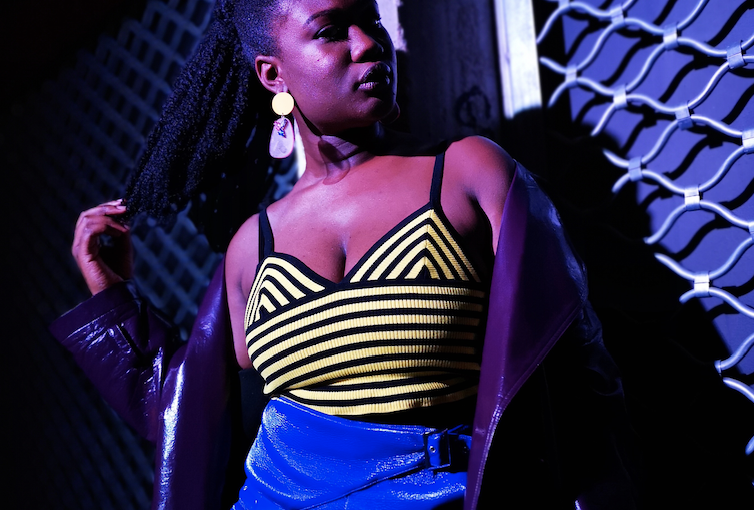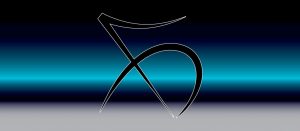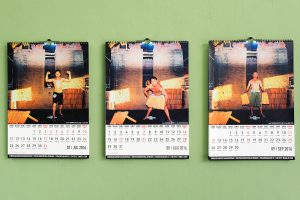The name of queer nightlife crew NADSAT recalls a secretive language in Anthony Burgess’ book A Clockwork Orange, slang spoken amongst a fleet of delinquent youth wandering hazardously across the dystopian corridors of near-future Britain. Although violence and vulgarity – in which language itself plays a role – provoke predictable tensions between social order, chaos, and morality, Burgess’ Nadsat dialect independently reflects a world of its own that escapes dominant hierarchies. Obscured origins and conventions lend power only to those that speak it. It’s a voice for which the mysterious Parisian collective, with the help of affiliates like CRYSTALLMESS and Sentimental Rave, provide a score on the self-titled NADSAT compilation, releasing via Because Music on January 22.

As stalwarts of the Paris underground electronic music scene, CRYSTALLMESS and Sentimental Rave play a key role in characterizing city’s club sound, regularly performing at local venues, radio stations, and international tours throughout Europe. A listen through the Sentimental Rave’s mix for AQNB reveals an acute blend of tracks inspired by 90’s hardcore rave with emerging DJs like Slikback and Estoc, a bridge between sounds of an era influential to the artist’s alias and a loose present-day iteration.
Meanwhile, CRYSTALLMESS covers various multi-disciplinary formats, including monthly NTS residency UNLEASHED, installations for Centre Pompidou’s MOVE festival, and Renaissance Society’s 24-hour broadcast IMAGE. SOUND. TEXT. The latter two represent the latest works of her art practice, an opus that addresses post-colonial narratives, collective memory, and post-digital aesthetics. In a recent interview, the artist highlighted disparities between the French mainstream and underground industries and the audience’s reluctance to embrace “the plurality of electronic music in general.”
I spoke with the artists over email to learn more about the NADSAT collective and its efforts to define the sound of post-lockdown Paris.
** Tell me about the Paris underground. I read Christelle’s thoughts on France’s commercial music industry and it seems like the city must be interesting to navigate. What role do the crews on the NADSAT release play in the scene?
CRYSTALLMESS: I guess no one on NADSAT has a specific functionality, they are doing things organically and that’s what makes them special. The main labels/crews involved are Casual Gabberz and Boukan Records, operating at different sides of the club music spectrum. They are passionate and have been about their respective sounds. But it is very important to stress that the compilation also showcases artists that navigate the scene without being associated with any crew in particular—free agents like me or Soraya (Sentimental Rave).
Sentimental Rave: I think NADSAT shows a lot about the French scene. It’s really diverse and implicated to represent different communities. If you take a look at each artist, for example, they don’t represent a scene but are part of a certain one, and when all this microcosm meets together, it’s interesting for the dynamic of our scene. Going against the uniformization of people and art in general shows that electronic music is more diverse than we tend to show usually. I think NADSAT is just a part of the diversity that we have in Paris, and it gives access to a more honest vision of what France is, even if it’s just an extract of the scene.

** I’ve felt ambivalent about the mainstream embracing ‘underground’ communities in terms of losing self-determinism for momentary visibility. What do you think?
CM: Which underground scene are we referring to? If we are speaking about the electronic music scene, probably but I still think it is pretty residual. What do you mean by “mainstream”? The audience? The mainstream media or the brands? I think the main thing would be to challenge the dichotomy between “underground”/“mainstream” because it is often unclear: are we speaking in terms of sounds or in terms of means (financial means, exposure)? Most people on the so-called underground scene are from educated and/or well-off backgrounds. And when they aren’t, they even more so depend on white gaze and institutions. They need to be palatable to them first. About visibility, I hope that 2021 will be the year of secrecy and abundance for me personally ahah.
SR: I think that if we have the choice it could be a bit more equal. By this, if the “underground” communities define by their alternative system and “avant gardiste” artists are dependent to the mainstream industry it can’t work and be beneficial for the underground scene, we have to be independent to take advantage of this. I do think the commercial scene defines their own system too, and run by an economy who tend to be closer to any form of capitalism, is trying to buy a bit of artistic credibility by giving visibility, space, and money to the underground artists. For me it’s always challenging to have a foot in commercial events run by people that might never understand what I’m doing and who I am and another in queer/smaller communities, struggling to run spaces and not determinate by the same economy or goal at all. Navigating between them could be useful to understand how to make it better for us if we are not locked in.
** Have your perspectives on nightlife changed at all in light of the pandemic? Any expectations for the next year?
CM: I would say I miss the physicality, the loudness, the warmth and sensuality. The adrenaline. I’m truly taking the measure of how central it is not only financially for a lot of artists, DJs but also staff workers but as place of socialization and boundless exploration. A space to create intimacy in the dark, and be vulnerable in the twilight.
Nonetheless, this pandemic has been a space for experimentation and questioning. Trying out new things. Me and Lafawndah created this DEDICATED PURE SONIC CURE performance night at Espace Neimeyer and cultural producer Yael Salomonovitz helped us produce it. It was centered around slowness, contemplation, a freestyle and mixture of intentions and attempt at communality. It lasted until midnight. Everyone had mezcal and our favorite artists Klein, Abdullah Miniawy & Simo Cell, TRUSTFALL, dancer Christian Yav, drummer Sebastien Forrester, and more were invited to perform (the audience was also invited to share poems, readings, thoughts).
My expectations are really simple: keep the insatiable desire for new music, physicality, body language alive and get artists paid. Since we have been locked in France affectively and physically for almost a year, this kind of moment of course show us that we’re not master of our time and life. With all the restrictions we are facing in this country about our freedom, with all the government’s disdain about the culture and the music, it changed. Even if I always was aware of what happened in this country, it’s clearer that no one will fight for us.
By this, I look at the importance of creating our own economy for the small scenes and trying to be more independent despite the big infrastructure and institutions that offered us visibility. What if we could do it on our own instead of waiting for someone to namedrop you somewhere?**
Track Listing:
Born in Flamez – Extract
Slikback – FAZA
COAL – Nailed
Schwefelgelb – Reflex ( An- I remix)
Vroom Vroom Hard Tek – DJ Gaiaonline
Clock – Code Walk
Forever Dilating Eve (Beyond the black rain) – Estoc
low income squad – ICES EYES EXOPLAN
Rapala700 & Nahshi – Hadze (Exploited Body Remix)
Slikback – 17MOB
Suicide Inside – Angel
Nan No Tame Ni Boku To Honyaku Shika – Bogdan Raczynski
NASDAT’s self-titled compilation is out via Because Music on January 22















